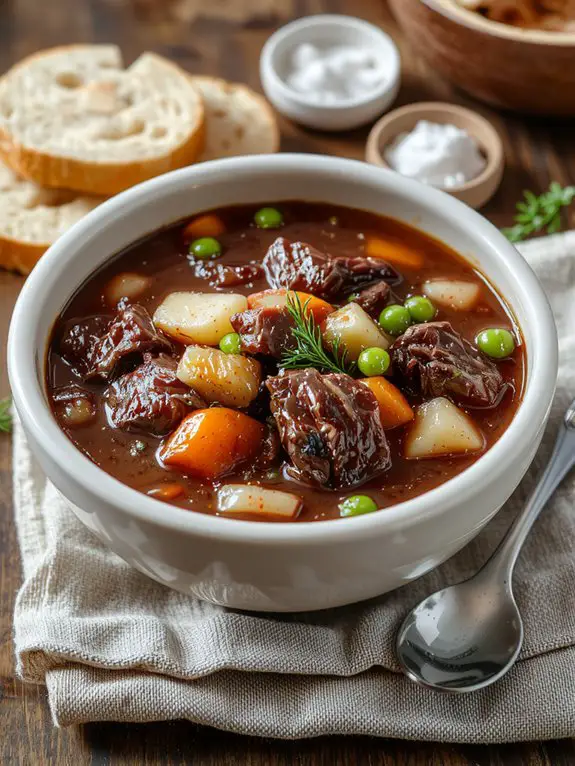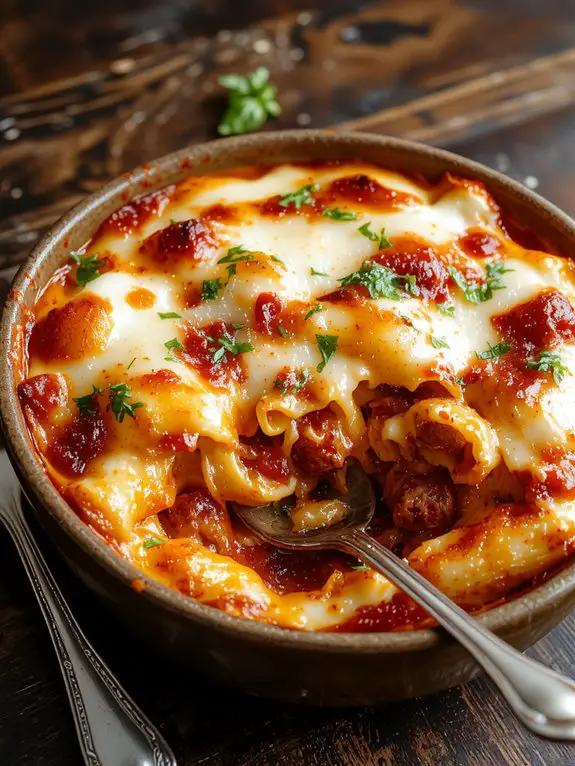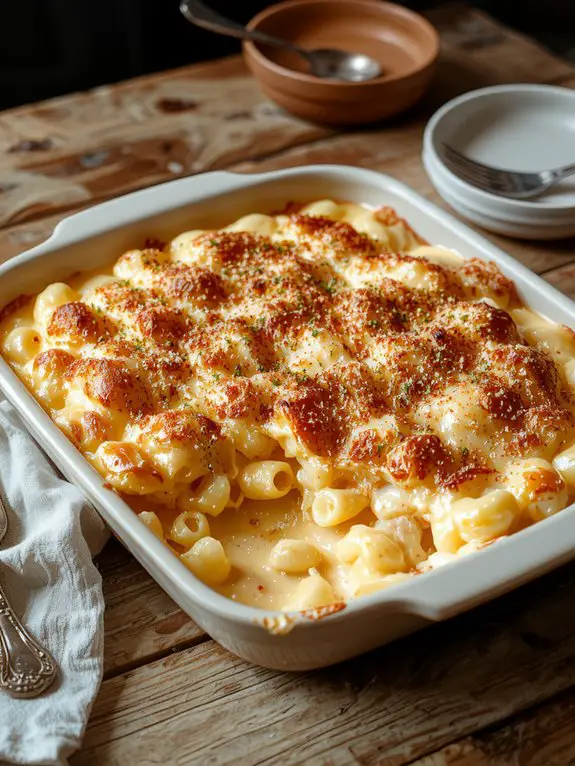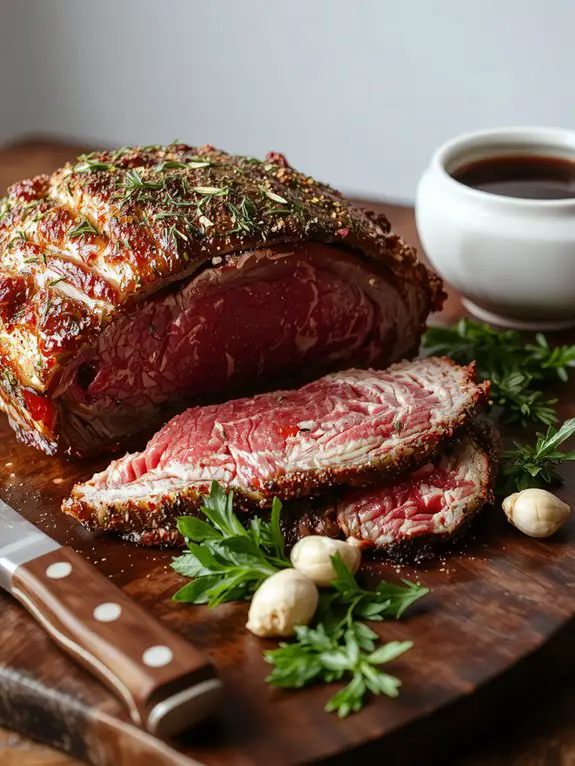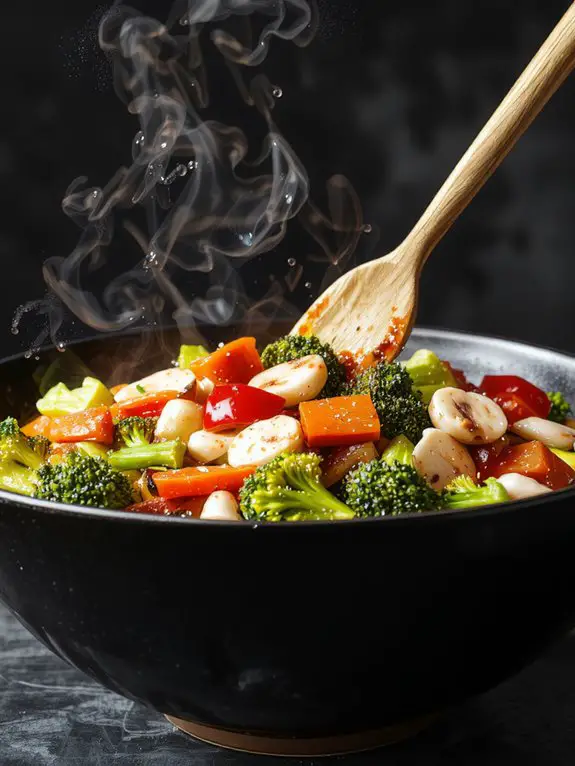I’ve spent years perfecting this beef stew recipe, and I’ll share why it’s become my go-to comfort meal. The secret isn’t just in the tender chuck roast or the rich wine reduction – it’s in the timing and technique that transforms simple ingredients into something extraordinary. There’s one pivotal step most home cooks skip that makes all the difference between ordinary stew and restaurant-quality results.
Recipe
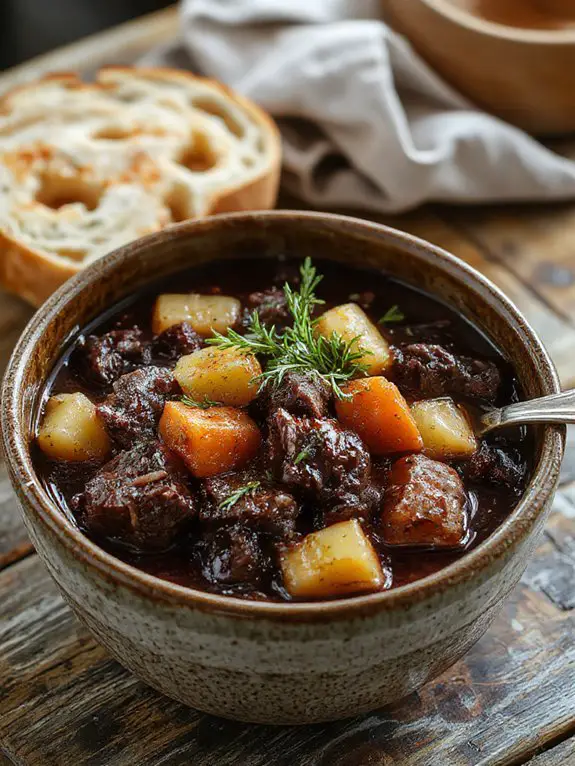
I’m going to be completely honest with you—this is the beef stew recipe that will ruin all other beef stews for you, and I’m not even sorry about it. After years of experimenting with different cuts of meat, layering techniques, and secret ingredients, I’ve cracked the code on what makes a truly exceptional stew, and it all comes down to three game-changing moves: searing the beef until it’s deeply caramelized (we’re talking about that gorgeous brown crust that screams flavor), building layers of richness with tomato paste and a splash of red wine, and using the perfect ratio of root vegetables that hold their shape while soaking up every drop of that incredible broth.
My family has been making stews for generations, but this version—with tender chunks of beef that practically fall apart at the touch of a fork, vegetables that are perfectly cooked but never mushy, and a rich, velvety gravy that coats everything like a warm hug—this is the one that finally made my picky teenage nephew ask for seconds.
The aroma alone will have your neighbors wondering what magic you’re working in your kitchen, with those deep, savory notes of herbs and wine mingling with the comforting scent of slow-simmered beef. Trust me, once you taste how the flavors meld together after a long, gentle simmer, creating this perfect harmony of hearty satisfaction in every single spoonful, you’ll understand why this recipe has become my go-to for everything from cozy Sunday dinners to impressing dinner guests who think they’ve tasted great beef stew before.
Ingredients
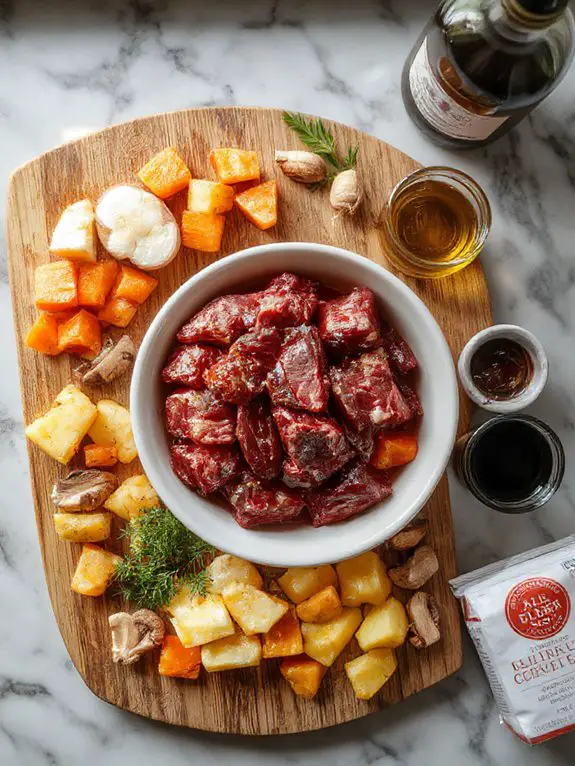
The secret to an unforgettable beef stew lies in choosing the right ingredients—and trust me, each one plays a starring role. While you can absolutely make substitutions based on what’s in your kitchen, there are a few non-negotiables that will transform your stew from good to absolutely phenomenal. Think of this as your insider’s guide to building layers of rich, comforting flavor that’ll have everyone asking for seconds.
The Beef (This is where magic begins!)
- 2-3 lbs chuck roast, cut into 2-inch cubes – Chuck is the MVP here with its perfect marbling that melts into tender, succulent pieces. Don’t even think about using lean cuts!
- Alternative: Beef short ribs or bottom round work beautifully, but avoid sirloin—it’ll turn tough and chewy
The Flavor Foundation
- 2 tbsp tomato paste – This concentrated powerhouse adds incredible depth and that gorgeous mahogany color. Toast it in the pot for 30 seconds for maximum impact!
- 1 cup red wine – Cabernet or Merlot are perfect, but honestly, whatever you’d drink works.
No wine? Beef broth with a splash of balsamic vinegar saves the day
• 6 cups low-sodium beef broth**** – Quality matters here! Better Than Bouillon is my secret weapon for restaurant-level richness
The Aromatic Dream Team
- 1 large yellow onion, diced – Sweet onions work too, but yellow gives that perfect savory base
- 4 garlic cloves, minced – Fresh only! Pre-minced just doesn’t deliver the same punch
- 3 sprigs fresh thyme – Dried works (use 1 tsp), but fresh thyme is absolutely worth seeking out
- 2 bay leaves – Don’t skip these flavor bombs! Just remember to fish them out before serving
The Vegetable All-Stars
- 1 lb baby potatoes, halved – Yukon Gold are perfection, but russets work if that’s what you have
- 3 large carrots, cut into 1-inch pieces – Go for the thick, mature carrots—they hold their shape beautifully
- 8 oz mushrooms, quartered – Baby bellas add earthiness, but button mushrooms are totally fine
The Thickening Power Players
- 3 tbsp all-purpose flour – For dredging the beef and building that silky, coating consistency
- 2 tbsp olive oil or vegetable oil – Avocado oil works great too for higher heat tolerance
How to Make the Best Slow-Simmered Beef Stew
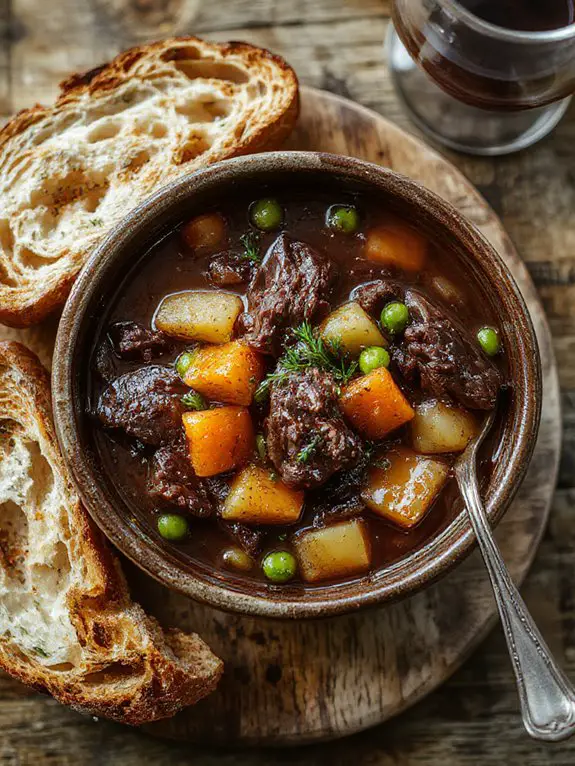
Pat the beef chunks completely dry with paper towels before seasoning generously with salt and pepper.
This vital first step guarantees proper browning instead of steaming. Moisture is the enemy of a good sear, so don’t rush this part. Season the beef about 15 minutes before cooking to let the salt penetrate the meat for deeper flavor.
Heat oil in a heavy-bottomed Dutch oven or large pot over medium-high heat until shimmering.
You’ll know the oil is ready when it moves freely around the pan and has a slight shimmer. Avoid using butter alone here—it will burn at the high heat needed for proper browning. A neutral oil with a high smoke point works best.
Brown the beef in batches, leaving space between pieces, for 3-4 minutes per side until deeply golden.
Overcrowding the pan will cause the meat to steam rather than sear. Work in 2-3 batches even if it seems tedious—this step builds the foundation of flavor for your entire stew. Don’t move the pieces too early; let them develop that beautiful caramelized crust.
Remove browned beef to a plate and reduce heat to medium before adding onions to the same pot.
The fond (those brown bits stuck to the bottom) is liquid gold for flavor. Lowering the heat prevents the onions from burning while they cook in the flavorful beef drippings. If the pan seems too dry, add a splash of oil.
Cook onions for 5-6 minutes until softened and translucent, scraping up any browned bits.
Use a wooden spoon to gently scrape the bottom of the pot as the onions release moisture. This helps deglaze the pan naturally and incorporates all that concentrated flavor back into your stew. The onions should look golden and smell sweet.
Add garlic and cook for 30 seconds until fragrant, stirring constantly.
Garlic can go from perfect to burnt in seconds, so watch carefully. You’ll smell that wonderful aroma almost immediately—that’s your cue that it’s ready. This brief cooking time removes the raw bite while preserving the garlic’s punch.
Sprinkle flour over the vegetables and stir constantly for 1-2 minutes.
This creates a roux that will naturally thicken your stew as it cooks. Make sure every bit of flour is absorbed and no white streaks remain. Cooking the flour eliminates any raw taste and helps it integrate smoothly with the liquid.
Slowly pour in wine or additional broth, scraping the bottom of the pot to release any remaining fond.
Add liquid gradually while stirring to prevent lumps from forming. The mixture might look messy at first, but keep stirring—it will come together beautifully. If you’re skipping wine, use extra broth or even a splash of balsamic vinegar for depth.
Return beef to the pot along with any accumulated juices, then add broth, tomato paste, and herbs.
Those juices on the plate are pure flavor—don’t waste them! Stir the tomato paste well to distribute it evenly; it adds umami and helps create a rich, deep color. Fresh herbs can be added as whole sprigs for easy removal later.
Bring to a gentle simmer, then reduce heat to low and cover partially.
You want just a few bubbles breaking the surface—a rolling boil will make the meat tough. Covering partially allows some evaporation for concentration while preventing too much liquid loss. This slow, gentle cooking is what transforms tough beef into fork-tender perfection.
Simmer for 1.5 to 2 hours, stirring occasionally, until beef is fork-tender.
The exact timing depends on your beef cut and cube size, so start checking at 90 minutes. The meat should yield easily to a fork with no resistance. If it’s still tough, keep cooking—patience is key for the best results.
Add carrots and potatoes during the last 45 minutes of cooking.
Adding vegetables too early will result in mushy, overcooked pieces. Root vegetables need enough time to become tender but should still hold their shape. Cut them in larger chunks since they’ll shrink slightly as they cook.
Stir in peas during the final 10 minutes and adjust seasoning with salt and pepper.
Frozen peas only need a few minutes to heat through and will maintain their bright color and slight bite. Taste and adjust seasonings now—the long cooking time will have concentrated flavors, so you might need less salt than expected.
Let the stew rest for 10 minutes before serving to allow flavors to meld and thickening to complete.
This brief rest helps everything come together beautifully. The stew will continue to thicken slightly as it cools, and the flavors will have a chance to marry. Serve with crusty bread to soak up every drop of that incredible broth.
Chef Tips

While following the basic steps will give you a solid stew, several professional techniques can elevate your dish from good to extraordinary.
I recommend honing your knife skills to guarantee uniform vegetable cuts for even cooking.
Don’t overlook plating techniques either – arrange components thoughtfully in bowls, garnish with fresh herbs, and serve with crusty bread alongside.
Nutrition
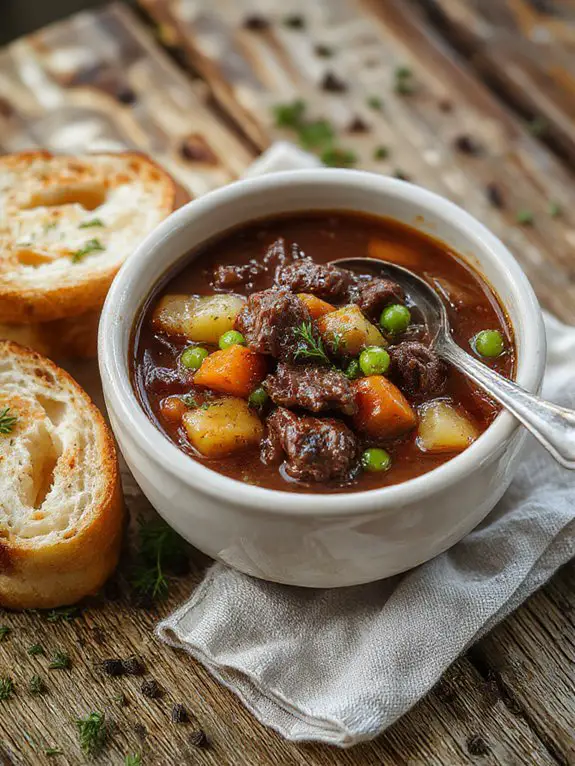
This hearty beef stew provides a well-balanced combination of protein, vitamins, and minerals. A single serving delivers substantial nutrition to fuel your day.
| Nutrient | Amount per Serving | % Daily Value |
|---|---|---|
| Calories | 285 | 14% |
| Total Fat | 8.5g | 11% |
| Saturated Fat | 3.2g | 16% |
| Cholesterol | 65mg | 22% |
| Sodium | 580mg | 25% |
| Total Carbohydrates | 28g | 10% |
| Dietary Fiber | 4.5g | 16% |
| Sugars | 8g | – |
| Protein | 26g | 52% |
| Vitamin A | 184mcg | 20% |
| Vitamin C | 12mg | 13% |
| Iron | 3.8mg | 21% |
| Potassium | 845mg | 18% |
What You’ll Love About This Recipe
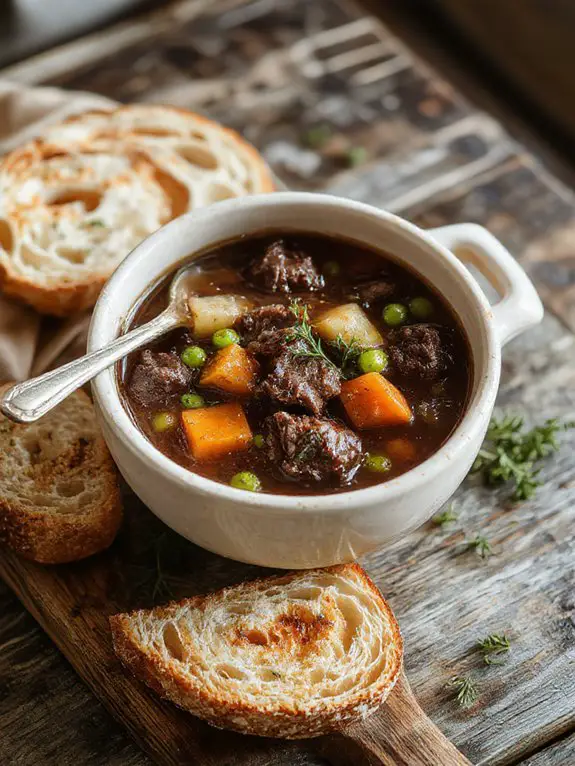
This hearty beef stew recipe will quickly become your go-to comfort food for chilly days and family gatherings. With tender chunks of beef, perfectly cooked vegetables, and a rich, savory broth that fills your kitchen with amazing aromas, it’s the kind of meal that brings everyone to the table with smiles.
Simple ingredients, extraordinary flavor – You probably have most of these pantry staples at home already, and the cooking process is so straightforward that even beginners can create restaurant-quality results.
One-pot wonder that saves time – Everything cooks together in a single pot, which means less cleanup for you and more time to enjoy with your loved ones while the stew works its magic.
Freezes beautifully for busy weeknights**** – Make a big batch on the weekend, and you’ll have delicious, homemade meals ready to reheat whenever life gets hectic, saving you from the takeout temptation.
Recipe Card
This hearty beef stew combines tender chunks of beef with a medley of vegetables in a rich, savory broth that’s perfect for cold days. The slow-cooking process allows the flavors to meld beautifully while creating fall-apart tender meat that’s deeply satisfying.
This classic comfort food recipe delivers warming spices and robust flavors that make it an ideal family dinner.
Ingredients:
- 2 lbs beef chuck roast, cut into 2-inch cubes
- 3 tablespoons vegetable oil
- 1 large onion, diced
- 3 cloves garlic, minced
- 3 tablespoons tomato paste
- 1/4 cup all-purpose flour
- 4 cups beef broth
- 1 cup red wine
- 2 bay leaves
- 1 teaspoon dried thyme
- 1 teaspoon salt
- 1/2 teaspoon black pepper
- 1 lb potatoes, peeled and cubed
- 3 large carrots, sliced
- 3 celery stalks, chopped
- 1 cup frozen peas
- 2 tablespoons fresh parsley, chopped
Instructions:
- Heat oil in a large Dutch oven over medium-high heat. Season beef cubes with salt and pepper, then brown on all sides, about 8-10 minutes total. Remove beef and set aside.
- Add onions to the same pot and cook until softened, about 5 minutes. Add garlic and cook for 1 minute more.
- Stir in tomato paste and cook for 2 minutes. Sprinkle flour over vegetables and stir to combine.
- Gradually add beef broth and red wine, stirring constantly to prevent lumps. Return beef to pot.
- Add bay leaves, thyme, salt, and pepper. Bring to a boil, then reduce heat to low, cover, and simmer for 1.5 hours.
- Add potatoes, carrots, and celery. Continue cooking for 30-45 minutes until vegetables are tender.
- Stir in frozen peas and cook for 5 minutes more. Remove bay leaves and garnish with fresh parsley before serving.
Notes:
Chuck roast provides the best flavor and texture for stewing. Don’t skip the browning step as it develops deep flavor.
The stew can be made ahead and reheated, which often improves the flavor. For thicker stew, mix 2 tablespoons cornstarch with cold water and stir in during the last 10 minutes of cooking.
Equipment:
Dutch oven or heavy-bottomed pot, cutting board, sharp knife, measuring cups and spoons
Time:
Prep time: 20 minutes
Cooking time: 2 hours 30 minutes
Cuisine:
American
Serving:
6 servings

